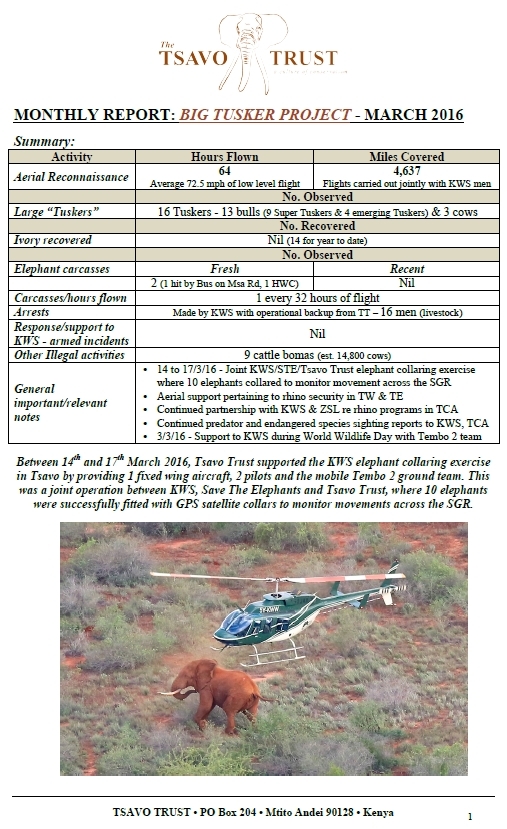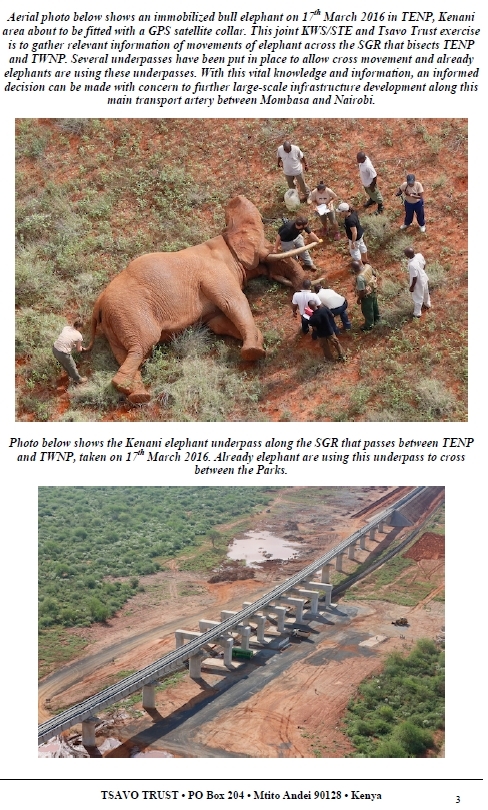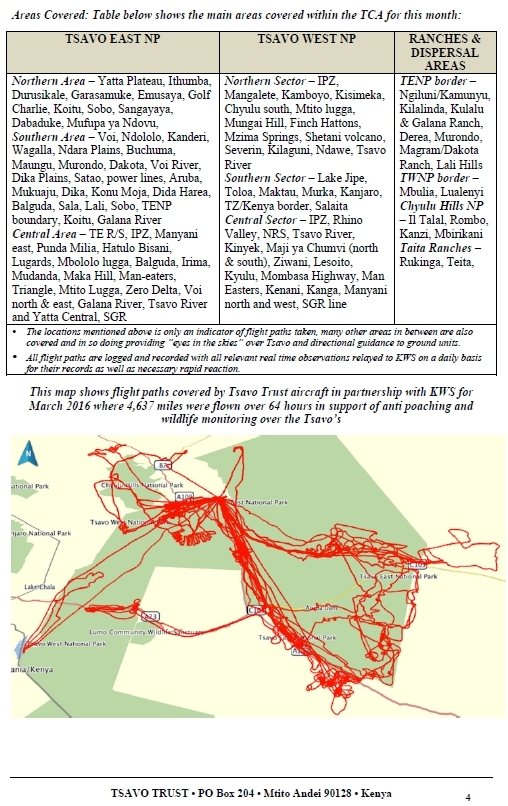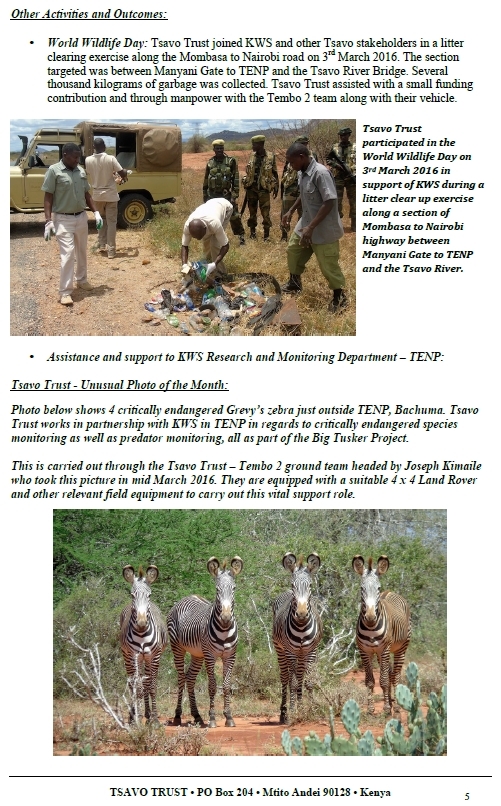Hi RP,
I did not intend the above post as a "Conspiracy Theory" entry - when you read my references combined with latter day international corruption revelations, a person can freely smell a rat. But, it will be endlessly wonderful if I am wrong an SANPARKS just plainly stupid.
The melenistic Serval you referred to is not directly referred to in the above reports but, I was surprised to see a photo of of a black serval on the Tsavo pages. I was fully aware of their existence in the Aberdare’s which is a tropical rain forested place, but not in the semi-desert of Tsavo !
Good for you to observe the low weight for such long tusks. East African elephants tend to quickly grow long tusks but as this happens at relatively young age, the nerve cavities are generally quite large and thus leading to lower than expected tusk weights.
And yes, I agree, the tusker in the report most likely died naturally. The KWS staff are expert in their field and will not hesitate to confirm poaching.
Africa's Giant Tuskers
- 100ponder
- Posts: 409
- Joined: Wed Mar 19, 2014 12:11 pm
- Country: RSA
- Location: Amanzimtoti, KwaZulu-Natal, South Africa.
- Contact:
Re: Tsavo Trust Monthly Report for March 2016.
The March 2016 report from the Tsavo Trust :-






Note :- The "underpass" referred to is something being practiced more and more in Kenya where game crossing roads becomes a problem. The roads are being fenced off and subways constructed under roads, railway lines and pipe lines on main game migration paths thus allowing game to pass under roads and railways without the hazard of accidents.






Note :- The "underpass" referred to is something being practiced more and more in Kenya where game crossing roads becomes a problem. The roads are being fenced off and subways constructed under roads, railway lines and pipe lines on main game migration paths thus allowing game to pass under roads and railways without the hazard of accidents.
- nan
- Posts: 26463
- Joined: Thu May 31, 2012 9:41 pm
- Country: Switzerland
- Location: Central Europe
- Contact:
Re: Africa's Giant Tuskers
what a good idea to built highway "in the air" 

Kgalagadi lover… for ever
https://safrounet.piwigo.com/
https://safrounet.piwigo.com/
- Lisbeth
- Site Admin
- Posts: 65720
- Joined: Sat May 19, 2012 12:31 pm
- Country: Switzerland
- Location: Lugano
- Contact:
Re: Africa's Giant Tuskers
Hopefully the ellies will learn to use the underpass 
Maybe the mentality is starting to change and the importance of wildlife recognized

Maybe the mentality is starting to change and the importance of wildlife recognized
"Education is the most powerful weapon which you can use to change the world." Nelson Mandela
The desire for equality must never exceed the demands of knowledge
The desire for equality must never exceed the demands of knowledge
- Richprins
- Committee Member
- Posts: 75197
- Joined: Sat May 19, 2012 3:52 pm
- Location: NELSPRUIT
- Contact:
Re: Africa's Giant Tuskers
Good stuff, 100p! 
Please check Needs Attention pre-booking: https://africawild-forum.com/viewtopic.php?f=322&t=596
- Mel
- Global Moderator
- Posts: 26737
- Joined: Sat May 19, 2012 12:31 pm
- Country: Germany
- Location: Föhr
- Contact:
Re: Africa's Giant Tuskers
Seeing the immobilized ellie and the people around him is astonishing... such a big bloke he is and so petty the (we) humans are. 
God put me on earth to accomplish a certain amount of things. Right now I'm so far behind that I'll never die.
- Lisbeth
- Site Admin
- Posts: 65720
- Joined: Sat May 19, 2012 12:31 pm
- Country: Switzerland
- Location: Lugano
- Contact:
Re: Africa's Giant Tuskers
I hope that you do not mind, 100Ponder, but I think that the following belongs here. If you want to, I can remove the post 
Africa’s Big Tuskers
( 14 beautiful photos )
)
Please note that for security reasons we do not provide names or specific locations of any living elephants featured in this issue. We call on our community not to speculate about the location or names of those elephants, and to join us in celebrating these treasures for what they are - African icons.
An elephant with tusks reaching the ground is typically defined as a big tusker. According to Rowland Ward’s records, the heaviest tusk of an African elephant weighed an astonishing 226lb (102.5kg), the heaviest tusk of a woolly mammoth weighed 201lb (91.2kg) and the heaviest tusk of an Asiatic elephant weighed 161lb (73kg). However, it is important to note that the longest tusks are not always the heaviest, as weight also depends on the circumference of the tusks. Lengthwise, the longest African elephant tusk measured around 3.5m, the longest woolly mammoth tusk measured around 4m and the longest Asiatic elephant tusk measured around 3m.
Unfortunately, hunters very much prize the so-called "hundred pounders" - elephants whose tusks weigh at least 45kg each. As a combined result of trophy hunting, large scale exploitation of ivory for consumer goods in the nineteenth and early twentieth centuries, and devastating poaching, big tuskers have almost been wiped off the African continent. Once a common sight, roaming far and wide across East, Central and Southern Africa, now there are very few big tuskers left on the whole continent.
In the above cover photo, you can admire an iconic big tusker against a spectacular backdrop. Now around 47 years old, this fine bull is just about to exit his prime, which is a period normally between 40 and 50 years old when big tuskers reach their peak reproductive age, as well as the climax of their power. This age coincides with the most pronounced growth of their tusks, which means that a lot of bulls draw unwanted attention during these years.
These elephants are like no others. They have captured our imagination. Big tuskers have become incredibly special and, almost two years after the death of Satao at the hands of poachers, we hope that this gallery not only celebrates the existence of big tuskers but does justice to their majesty as the very last of their kind.
In November 2014 this elephant was treated from a wound that was probably caused by poachers, which further highlights how stringent measures need to be taken to protect these amazing animals. A combination of solutions, including constant surveillance, armed protection, relocation and artificial insemination programmes, is arguably the way forward. As Satao's tragic death has proven, simple armed protection is not enough and big tuskers need armed guards to monitor them 24/7 - a similar protection to that which was enjoyed by an iconic bull called Ahmed in the Marsabit National Park in Kenya in the 1970s.
To find out more about the author of this incredible gallery, head to the last page.
Africa’s Big Tuskers
( 14 beautiful photos
Please note that for security reasons we do not provide names or specific locations of any living elephants featured in this issue. We call on our community not to speculate about the location or names of those elephants, and to join us in celebrating these treasures for what they are - African icons.
An elephant with tusks reaching the ground is typically defined as a big tusker. According to Rowland Ward’s records, the heaviest tusk of an African elephant weighed an astonishing 226lb (102.5kg), the heaviest tusk of a woolly mammoth weighed 201lb (91.2kg) and the heaviest tusk of an Asiatic elephant weighed 161lb (73kg). However, it is important to note that the longest tusks are not always the heaviest, as weight also depends on the circumference of the tusks. Lengthwise, the longest African elephant tusk measured around 3.5m, the longest woolly mammoth tusk measured around 4m and the longest Asiatic elephant tusk measured around 3m.
Unfortunately, hunters very much prize the so-called "hundred pounders" - elephants whose tusks weigh at least 45kg each. As a combined result of trophy hunting, large scale exploitation of ivory for consumer goods in the nineteenth and early twentieth centuries, and devastating poaching, big tuskers have almost been wiped off the African continent. Once a common sight, roaming far and wide across East, Central and Southern Africa, now there are very few big tuskers left on the whole continent.
In the above cover photo, you can admire an iconic big tusker against a spectacular backdrop. Now around 47 years old, this fine bull is just about to exit his prime, which is a period normally between 40 and 50 years old when big tuskers reach their peak reproductive age, as well as the climax of their power. This age coincides with the most pronounced growth of their tusks, which means that a lot of bulls draw unwanted attention during these years.
These elephants are like no others. They have captured our imagination. Big tuskers have become incredibly special and, almost two years after the death of Satao at the hands of poachers, we hope that this gallery not only celebrates the existence of big tuskers but does justice to their majesty as the very last of their kind.
In November 2014 this elephant was treated from a wound that was probably caused by poachers, which further highlights how stringent measures need to be taken to protect these amazing animals. A combination of solutions, including constant surveillance, armed protection, relocation and artificial insemination programmes, is arguably the way forward. As Satao's tragic death has proven, simple armed protection is not enough and big tuskers need armed guards to monitor them 24/7 - a similar protection to that which was enjoyed by an iconic bull called Ahmed in the Marsabit National Park in Kenya in the 1970s.
To find out more about the author of this incredible gallery, head to the last page.
"Education is the most powerful weapon which you can use to change the world." Nelson Mandela
The desire for equality must never exceed the demands of knowledge
The desire for equality must never exceed the demands of knowledge
- Mel
- Global Moderator
- Posts: 26737
- Joined: Sat May 19, 2012 12:31 pm
- Country: Germany
- Location: Föhr
- Contact:
Re: Africa's Giant Tuskers
Woah! They are really impressive!  My top favourites would be the first one and no. 11 though.
My top favourites would be the first one and no. 11 though. 
Shame, I can't nominate them for the landscape pix.
Shame, I can't nominate them for the landscape pix.
God put me on earth to accomplish a certain amount of things. Right now I'm so far behind that I'll never die.


